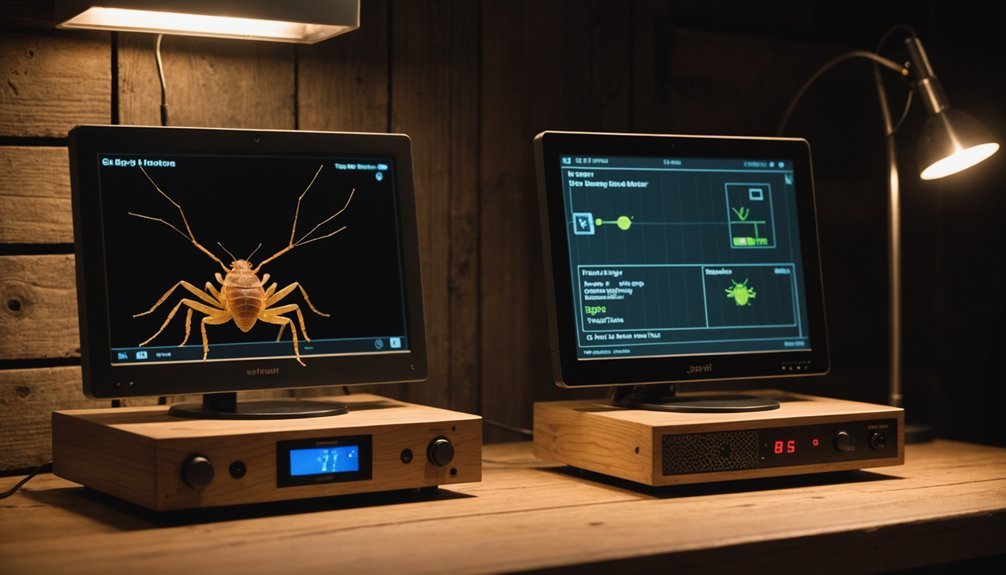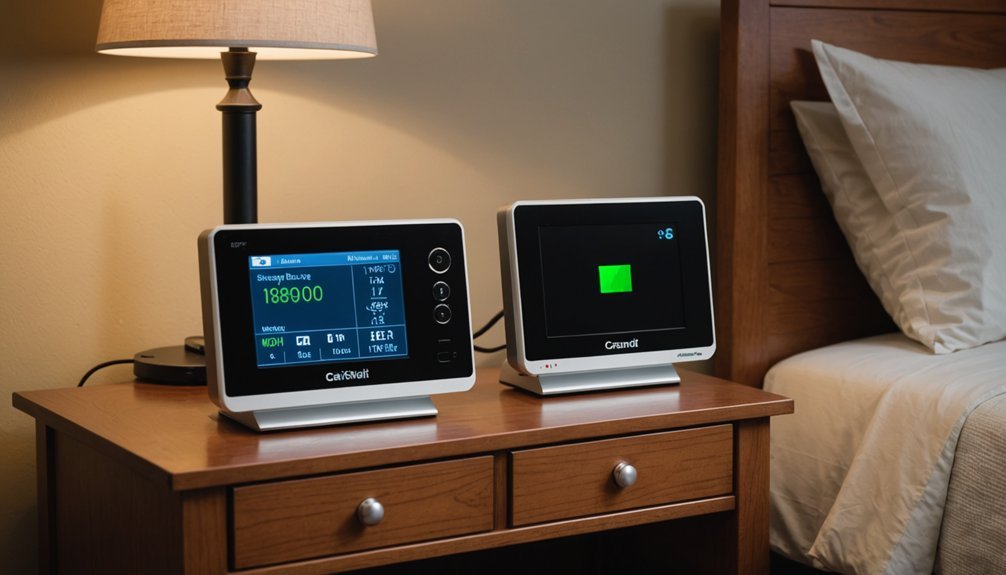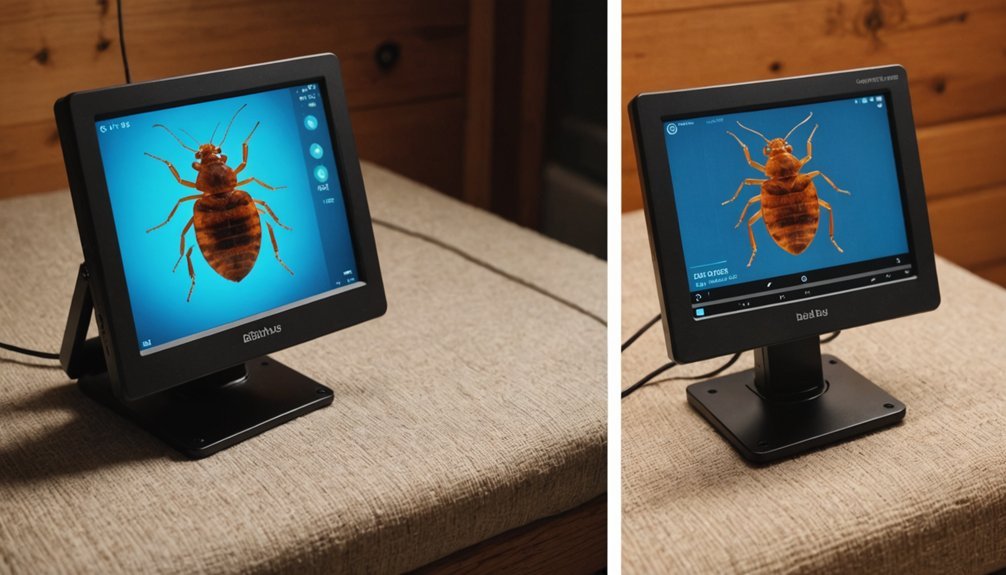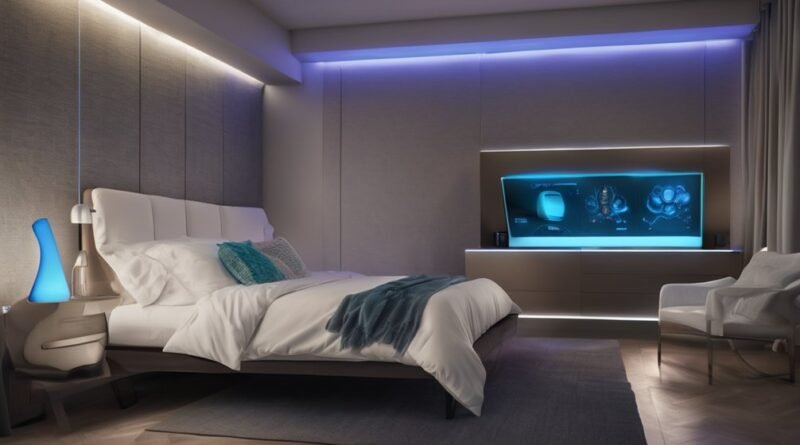Best Bed Bug Monitors: Active Vs Passive Explained
You’ve probably heard the horror stories about bed bug infestations, but you don’t have to wait until it’s too late to detect these unwanted guests. Whether you choose an active monitor with high-tech attractants or a simple passive device, understanding the key differences will determine your success rate. Before you make your choice, you’ll want to weigh essential factors like detection speed, maintenance needs, and budget considerations.
Key Takeaways
- Active monitors detect bed bugs faster (24-96 hours) using CO2, heat, and chemical lures, while passive monitors need 7-14 days.
- Passive monitors are more budget-friendly and low-maintenance, costing about 8¢ per day over a year.
- Active monitors maintain consistent capture rates across all infestation sizes, while passive monitors become less effective with larger infestations.
- Active monitors require regular maintenance and power sources but offer over 99% accuracy in detection.
- Passive monitors use pitfall traps with slick surfaces, capturing at least 5% of bed bugs within 24 hours.
Understanding Active and Passive Bed Bug Monitors

When choosing between bed bug monitors, you’ll need to understand the key differences between active and passive types.
Active monitors use attractants like CO2, heat, and chemical lures to draw bed bugs out of hiding, while passive monitors rely on natural bug behavior and strategic placement to capture them.
You’ll find active monitors work best in unoccupied rooms since they mimic host signals, incorporating multiple attractants to target different behavioral responses.
Passive monitors, on the other hand, depend on placement near harborage areas and travel paths, often using pitfall traps under furniture legs. The Climbup Insect Interceptor has proven more reliable than visual inspections alone for detecting infestations.
While both types can detect low-level infestations effectively, active monitors tend to maintain consistent capture rates regardless of population size.
However, they’re typically more expensive and require regular maintenance compared to their simpler, passive counterparts.
Key Features and Mechanisms of Each Monitor Type

When you compare active and passive bed bug monitors, you’ll find active models use sophisticated combinations of heat, CO₂, and pheromones to draw bugs in, while passive traps rely on strategic placement and natural bug movement patterns.
Active monitors’ core design elements include specialized lures and capture mechanisms that can detect infestations with over 99% accuracy, though they’re typically more expensive and complex than their passive counterparts. The NightWatch monitor requires at least 14 days operation for effective bed bug detection and prevention.
The attraction methods differ markedly – active monitors simulate human presence through multiple sensory triggers, while passive designs use structural elements like textured surfaces and adhesives to intercept bugs along their natural travel paths.
Operating Principles Compared
While both active and passive bed bug monitors serve the same detection purpose, they operate on fundamentally different principles.
Active monitors use attractants like CO2, heat, and chemical lures to draw bed bugs out, mimicking human hosts. In contrast, passive monitors rely on intercepting bugs during their natural movement patterns without using attractants. The quick detection capabilities of active monitors make them ideal for confirming suspected infestations.
- Active monitors require regular maintenance and replacement of components but offer enhanced detection through multiple attractant mechanisms.
- Passive monitors are maintenance-free and cost-effective, working through simple physical interception.
- Active systems combine multiple attractants for better effectiveness, especially in low-density infestations.
- Passive devices depend heavily on strategic placement near bed bug pathways.
- Active monitors typically provide more consistent capture rates across different infestation levels, while passive monitors excel at early detection.
Core Design Elements
The core design elements of bed bug monitors reveal distinct engineering approaches between active and passive systems.
Passive monitors feature two concentric containers made of rigid plastic, creating pitfall traps with slick inner surfaces that prevent bugs from escaping. You’ll find them easy to install around bed legs, requiring minimal maintenance beyond visual checks.
Active monitors incorporate electronic components and stimuli-emitting elements housed in durable plastic. They’ll need power sources to operate heat panels and CO2 release mechanisms. The dual monitor approach has proven to detect up to 90% of bed bugs within two weeks of deployment.
You’ll notice their sophisticated controlled release systems for attractants, designed to mimic host cues. While they’re more complex to maintain, requiring regular attractant replenishment and battery changes, they offer greater placement flexibility since they don’t rely on human presence to lure bed bugs.
Attraction Methods Breakdown
Modern bed bug monitors employ distinct attraction methods that range from simple physical traps to sophisticated multi-sensory systems.
You’ll find passive monitors utilizing natural bed bug behavior, relying on physical barriers and pitfall designs to intercept these pests during their normal foraging activities. Early detection through these monitors is crucial since timely treatment can prevent major infestations from developing.
Active monitors, however, incorporate multiple stimuli to draw bed bugs out of hiding.
- CO2 emission systems mimic human breath, triggering bed bugs’ host-seeking instincts
- Chemical lures and synthetic pheromones can double trap effectiveness when properly formulated
- Heat elements simulate body temperature, encouraging bugs to emerge from their refuges
- Passive designs leverage bed bugs’ tendency to travel along furniture edges and legs
- Combined approaches using CO2, heat, and chemical attractants typically yield the highest catch rates
Comparing Performance and Detection Rates

You’ll find active monitors detect bed bugs faster than passive ones, typically within 4-7 days using CO2 and heat attractants.
Both monitor types achieve similar capture rates of 7-12% regardless of infestation level, though active monitors maintain more consistent detection across varying population densities.
Your choice between monitor types should factor in room occupancy, as passive monitors work best in occupied spaces while active ones excel in both occupied and vacant areas.
Detection Speed Comparison
When comparing bed bug detection methods, active monitors consistently outpace their passive counterparts in speed, typically identifying infestations within 24-96 hours versus the week or longer needed for passive devices.
You’ll find that CO2-based active monitors like NightWatch work especially well during bugs’ natural feeding cycles, while passive interceptors rely solely on random bug movement.
- Active monitors deliver quick results using attractants like CO2 and heat, ideal for early detection
- Passive devices require 7-14 days to achieve similar detection confidence levels
- CO2-emitting devices maintain consistent capture rates across different infestation sizes
- Homemade dry ice traps often detect bugs faster than some commercial active monitors
- Passive monitors eventually match active detection rates over extended periods but take longer initially
Population Size Accuracy
Beyond detection speed, understanding a monitor’s ability to accurately reflect bed bug population size shapes its overall effectiveness.
You’ll find active monitors maintain consistent capture rates across varying population densities, while passive monitors become less proportionally accurate as infestations grow larger.
To get the most accurate population estimates, you’ll want to combine visual inspections with strategically placed passive interceptors under furniture legs.
Using multiple monitors per room helps average out spatial variations in bed bug activity.
While both types reliably capture at least 5% of bugs within 24 hours, active monitors with attractants provide more consistent relative captures.
However, their cost and maintenance needs might limit long-term deployment.
For best results, place multiple monitors across different locations rather than relying on a single device.
Location-Based Capture Rates
Three key factors influence bed bug monitor capture rates across different locations: placement strategy, monitor type, and infestation level.
You’ll find significant variations in detection rates from 3.4% to 25.6%, depending on these variables.
- Pitfall-style monitors like ClimbUp BG and BlackOut traps perform equally well regardless of their placement near beds or along baseboards.
- Color variation between black and white monitors shows minimal impact on capture success.
- Active monitors with chemical lures can boost catch rates by up to 67% compared to unbaited versions.
- Monitors placed near beds and seating areas typically show higher detection rates due to natural bed bug foraging patterns.
- Placement along room perimeters and hallways effectively captures dispersing bugs that might otherwise go undetected.
These findings suggest you can achieve reliable detection by strategically positioning monitors throughout your space.
Cost Analysis and Maintenance Requirements
Although bed bug monitors are essential tools for early detection, their costs and maintenance requirements vary considerably between passive and active systems.
You’ll find passive monitors are more budget-friendly upfront, costing as little as 8¢ per day over a year, while active electronic systems require a higher initial investment due to their advanced technology.
When it comes to maintenance, you’ll need to inspect passive monitors monthly or more frequently, cleaning adhesive surfaces and repositioning devices as needed.
Active monitors, however, often provide automated detection and remote alerts, reducing your labor costs despite higher upfront expenses.
While passive systems need more hands-on attention, they typically have longer service intervals with no chemical attractants to replace.
Your choice should depend on your facility’s scale and available resources.
Strategic Placement and Installation Guidelines
When placing bed bug monitors effectively, you’ll need to focus on strategic locations where these pests commonly travel and hide. Start by positioning traps under each leg of beds and furniture, as these are critical interception points during feeding times.
Remember to take into account both active and passive monitors based on your specific situation and infestation level.
- Place smooth-walled traps with moat designs under furniture legs to prevent escapes
- Target high-risk areas like bedrooms, mattress seams, and furniture joints
- Check monitors weekly or biweekly to track activity patterns and trends
- Include common areas and entry points in multi-unit buildings for thorough coverage
- Integrate your monitoring with regular cleaning and maintenance to maximize effectiveness
Regular inspection and proper placement are key to early detection and successful bed bug control.
Making the Right Choice for Your Situation
Choosing the right bed bug monitor depends heavily on your specific needs, budget, and monitoring goals.
Effective bed bug monitoring starts with understanding your situation, whether you need basic detection or comprehensive surveillance solutions.
If you’re looking for a low-maintenance, cost-effective solution, passive monitors are your best bet. They’re reliable, capturing at least 5% of bed bugs, and don’t require power or attractant replacements.
For situations demanding quick detection, especially in low-infestation scenarios, you’ll want to evaluate active monitors. While they’re pricier and need regular maintenance, they offer enhanced sensitivity through CO2 and heat attractants.
If you’re a pest control professional or managing a sensitive environment like a hospital, this increased detection speed can justify the higher investment.
Assess your space constraints too. Active monitors work well in open areas, while passive monitors need specific furniture placement.
For budget-conscious DIY solutions, sugar-yeast CO2 traps offer a middle ground.
Conclusion
When you’re deciding between active and passive bed bug monitors, weigh your priorities carefully. If you need quick, highly accurate detection and don’t mind the higher costs and maintenance, go with active monitors. If you’re on a budget and can wait longer for results, passive monitors will serve you well. Consider your space, budget, and urgency to make the best choice for your situation.

